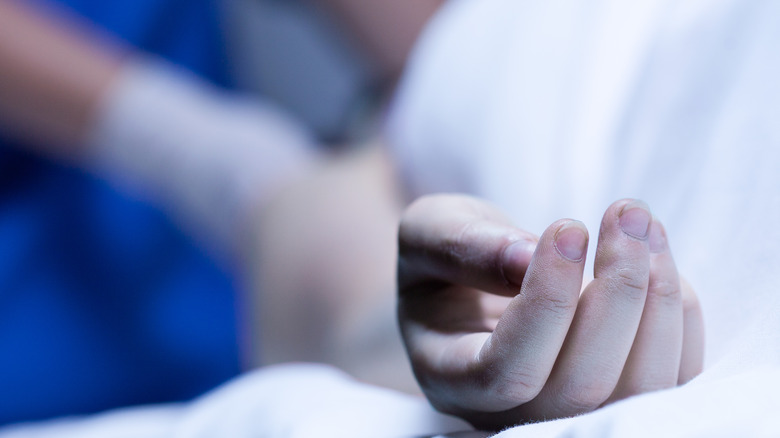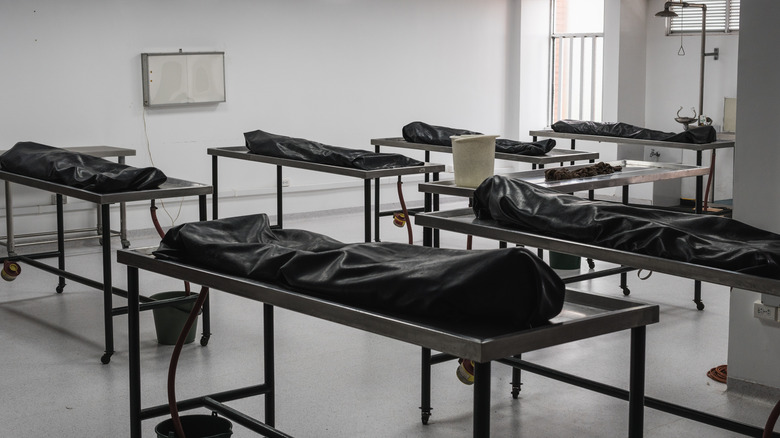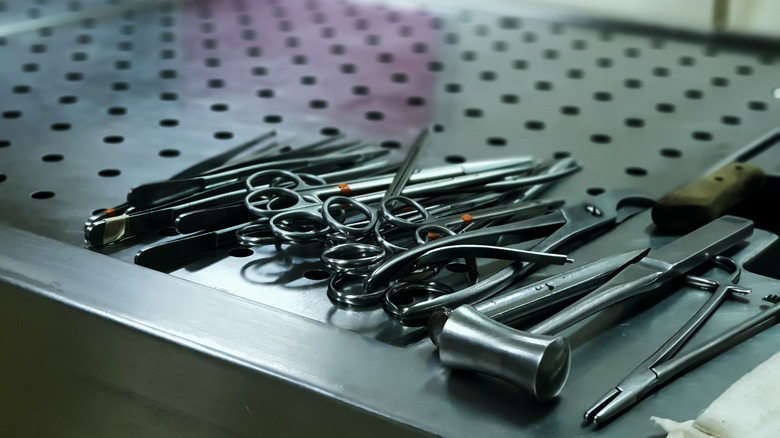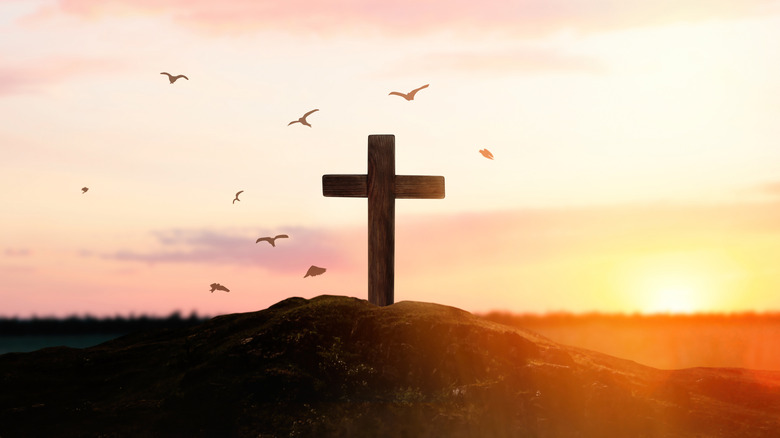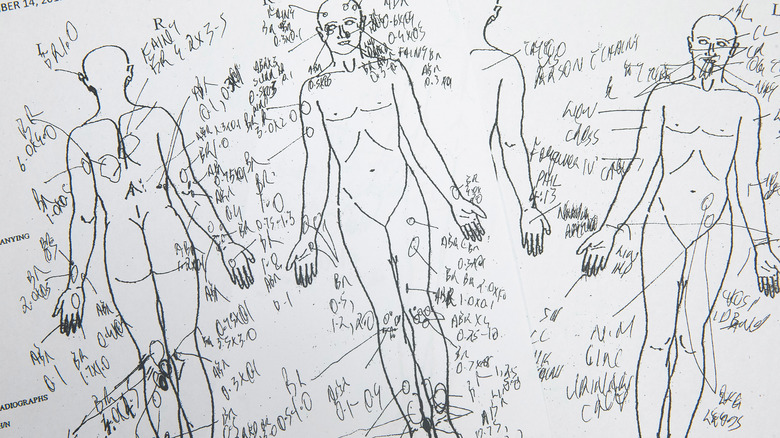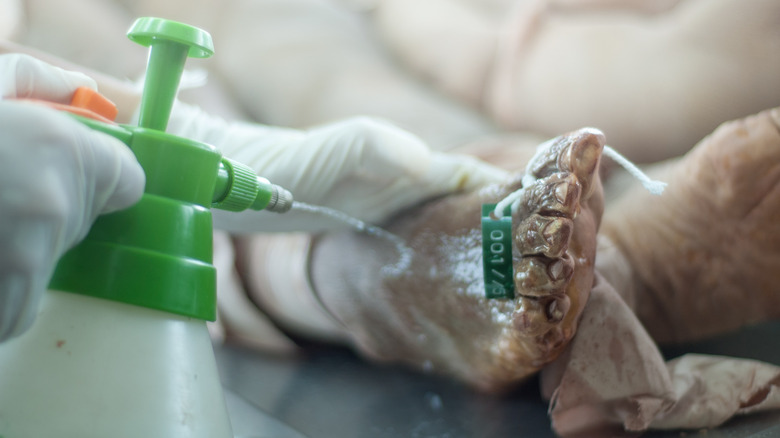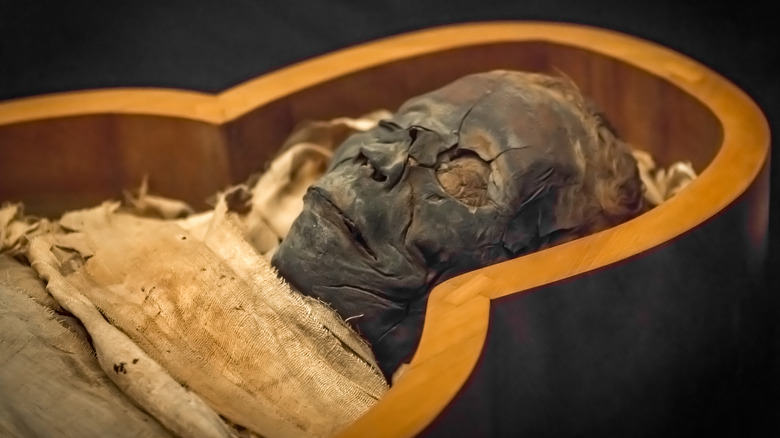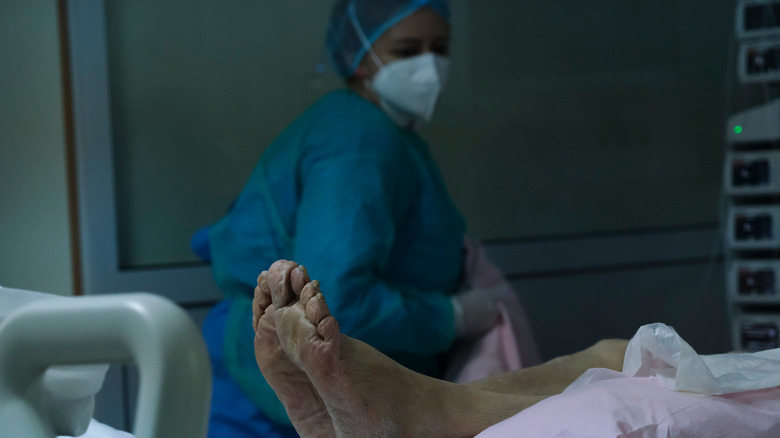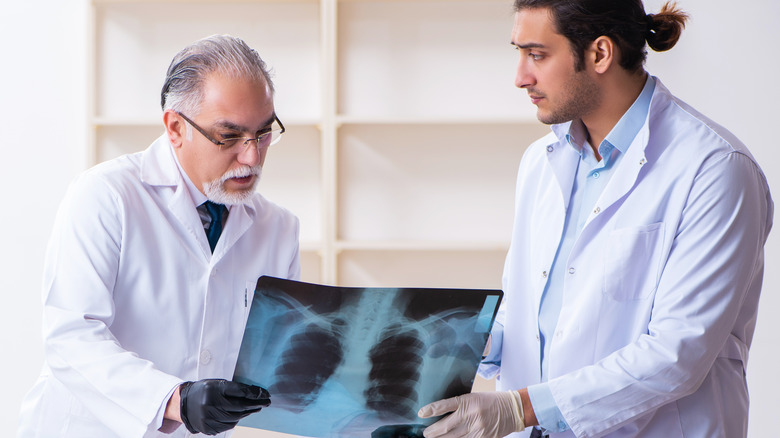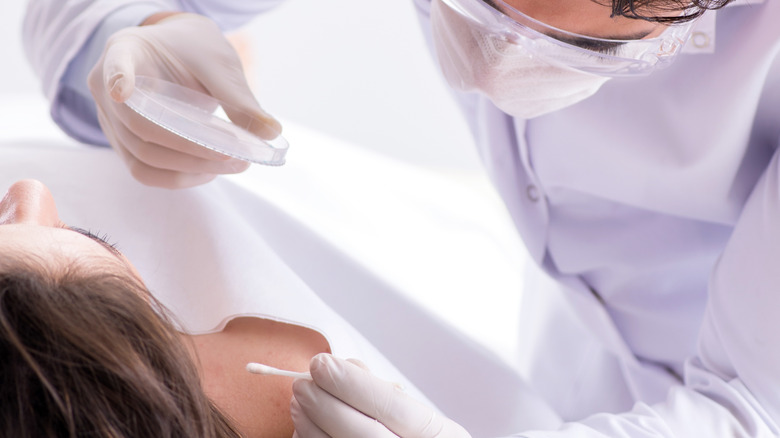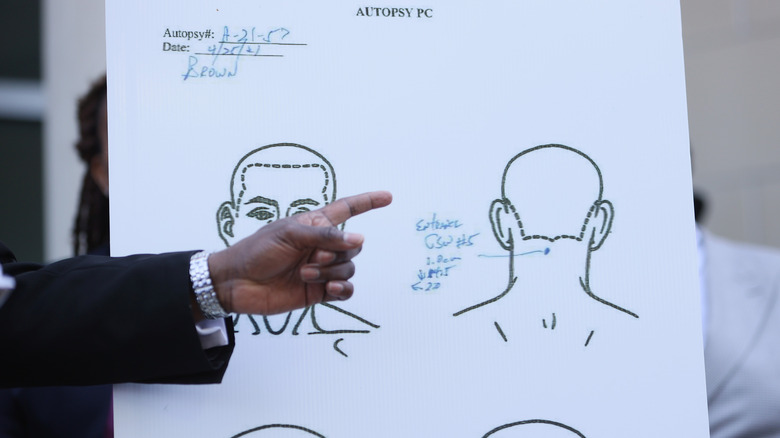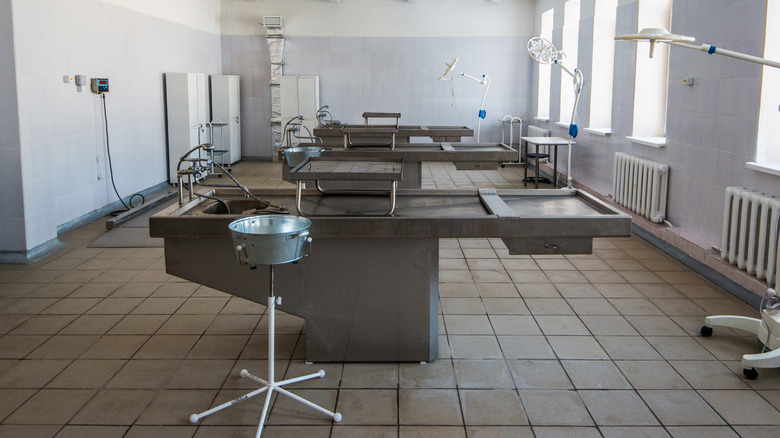13 Myths About Autopsies That Just Aren't True
The postmortem process known as the autopsy traces its roots to as far back as three centuries before the beginning of the Common Era. According to Popular Mechanics, the Egyptian ruler Ptolemy I Soter first permitted the dissection of dead human bodies (typically belonging to those sentenced to death) for educational reasons, reportedly even participating in some of the operations himself. Nearly 250 years later, Julius Caesar became the first recorded person to be autopsied; it was through this procedure that the Roman physician Antistius was able to determine not just the number of stab wounds Caesar sustained, but also which of them took his life.
Despite being a staple of police procedural dramas and other works of popular culture, the autopsy isn't as prominent as it used to be. Still, it remains a valuable method for determining cause of death, especially when dealing with casualties of suspected crimes. That said, there are many misconceptions about the practice, partly fueled by its portrayal in popular media. Here are a few myths about autopsies that just aren't true.
Most deaths lead to an autopsy
Autopsies provide valuable information about the deceased. At times, they may even contribute to existing bodies of knowledge about certain illnesses and causes of death. In general, a body is subjected to an autopsy if the deceased has perished due to ambiguous, unknown, or potentially crime-related reasons (via Popular Mechanics).
Additionally, autopsies allow examiners to identify serious mistakes in diagnoses immediately before death, as stated in American Scientist. Even with various technological advancements in the field of postmortem investigation, autopsies are still the best way to find said errors. That said, an autopsy isn't automatically lined up for a person when they die — not even when they're a suspected victim of a crime — nor does it happen for the majority of the population. In fact, the autopsy rate has been steadily declining since midway through the 20th century.
According to Medscape, the global decline of autopsy rates began in the 1950s. During this decade, autopsy rates were reportedly "steady at over 50 percent." In particular, the autopsy rate for all hospital deaths in the United States was said to range from 40 to 60% prior to 1970. Recent years, however, have seen a drastic drop in the number of autopsies conducted annually. Experts believe that worldwide, autopsies follow less than 5% of all deaths.
Autopsies leave corpses mutilated
After seeing how autopsies are done on TV shows and in movies, one might assume that every autopsy involves leaving the body horribly scarred and looking vastly different from how it originally was. This could not be further from the truth, though, as professionals who conduct autopsies make sure that bodies are not left mutilated messes.
As MedicineNet explains, any cuts and incisions on the body are sewn shut after the autopsy procedure. The organs aren't always returned, though, depending on whether or not they're still needed as educational tools or research materials post-autopsy. As a general rule, autopsied bodies should still look presentable in an open casket, with any cuts concealed by makeup or clothes.
Throughout the years, experts have developed methods and technologies to reduce the reliance on invasive autopsy practices, according to American Scientist. Some of these newer techniques and tools include radiologic imaging, which may eliminate the need for incisions on the deceased while also generating faster results. With these methods, those conducting an autopsy can obtain crucial information about how and why the victim died, while reassuring family members that touching and cutting their loved one can be kept to a minimum.
Religions generally forbid autopsies
Understandably, some people object to the very idea of an autopsy for their loved ones, with some citing religious beliefs as their main reason. While it is certainly important for any autopsy to take religious and cultural sensibilities into consideration, the reality is that few religions directly oppose the practice. In fact, according to Medscape, most cultures and religions aren't that strict about autopsies, especially in situations where they are absolutely needed to provide closure to a victim's case.
A 2001 paper into autopsy and religion states that none of the dominant religions in the areas of the world where autopsies are conducted outright ban the practice for their believers. Buddhists, for instance, are reportedly "finding ways to dialogue with the need of medical practices in the western world," while Christians not only allow autopsies, but also encourage "the generosity of donation."
Meanwhile, Jews and Muslims have similar views on invasive autopsies, that is autopsies that involve "cutting open a body and removing internal organs." Jews and Muslims believe that such procedures desecrate the body (via The Independent), but these religions do not completely ban autopsies. As much as possible, religious followers simply encourage blood tests or non-invasive examinations (i.e. scans). A 2015 ruling from the High Court of Justice in England supports this.
An autopsy will always determine the cause of death
As MedicineNet explains, the primary reason behind autopsies is to figure out what caused the person's demise, whether it's for academic purposes or for solving a crime. Contrary to what you might expect, however, an autopsy doesn't always reveal this information.
For example, if a person died from a heart attack or a stroke, there would be noticeable signs on the body that could point to this conclusion. On some occasions, the person conducting the autopsy can figure out the cause of death quickly without a full autopsy (via the Los Angeles County). In many cases, though, figuring out the cause of death isn't as simple and straightforward. Lab tests on the body and samples obtained from it can take weeks or even months, and there's no guarantee that the actual cause of death will be revealed.
It's also important to differentiate the cause of death from the manner of death. According to the experts at the Death Investigation Academy, the cause of death refers to what actually ended the victim's life, such as a critical injury or an incurable illness. Meanwhile, the manner of death deals with the how: Did the victim die in an accident? Was the death natural (i.e. due to a disease)? Did someone murder the person, or did they take their own life? The manner of death may also be classified as "undetermined" if the autopsy results are inconclusive.
An autopsy is just a hassle that delays the funeral
Some objections to autopsies come from family members who are worried that it will take longer for their loved ones to finally be laid to rest because of the postmortem procedure. The Yale School of Medicine, however, makes it clear that coordination between the family and funeral directors can ensure that any arrangements would not be pushed back by the autopsy.
Johns Hopkins Medicine lists down a number of reasons to conduct an autopsy, including the occurrence of a "suspicious or unexpected death," a disease outbreak or similar public health issue, or there simply not being enough information about the deceased to figure out what killed them. Some of the numerous yet hardly recognized benefits of autopsies include the revelation of information that leads to enhanced prosthetics, as well as the diagnosis of previously undetected health issues. One high-profile example of an autopsy playing a crucial role in revealing the truth took place in 2009, when Michael Jackson's autopsy results showed that a propofol overdose killed him, exacerbated by sedatives that his tour doctor and cardiologist gave him the day that he died (via Popular Mechanics).
While the results of the autopsy may take a while to process, the procedure itself isn't that time-consuming so need not cause much delay. In most cases, a regular autopsy can finish within four hours.
An autopsied corpse cannot be embalmed
Another misconception about autopsies is that once they're conducted, the autopsied body can no longer be embalmed. However, as forensic pathologist Dr. Raquel Fortun explained in an interview with Inquirer.net, this isn't actually the case. However, if an autopsy is to be performed, it must take place before the body is embalmed, as the embalming process could affect the corpse in a way that corrupts or even removes the evidence that could have been obtained from it. Dr. Fortun recommends refrigerating the body to preserve it instead of embalming it immediately, "Because embalming contaminates the body, it's an invasive procedure [where] you inject and cut."
A 2013 article in The Guardian describes a "typical" embalming as told by Jenn Park-Mustacchio, a professional embalmer and funeral director. Her account indicates that the average embalming process does involve a lot of contact and cutting. Unsurprisingly, Park-Mustacchio also clarified that if the person being embalmed died from a car accident, murder, or by taking their own life, the embalmer would go about the process in a "drastically different" way.
Autopsies can only be done on the freshly deceased
Due to how they are usually shown in TV shows and other media, many of us associate autopsies with people who have recently perished. However, scientific advancements in the autopsy process have allowed today's experts to conduct the procedure on people who have long expired — and in some cases, direct touch and contact aren't even necessary.
One interesting example, as told by Popular Mechanics, involves Nesperennub, a 3,000-year-old mummified priest at the British Museum. Using a touch-free procedure called a virtopsy (a portmanteau of the words "virtual" and "autopsy"), experts were able to study the corpse without physically compromising it. Instead, they "virtually unwrapped" the mummified Nesperennub via a computerized tomography (CT) scan. They then applied visualization techniques on the data they obtained from the mummy.
An autopsy also became the key to shedding light on what may be the earliest murder in human history. FlipScience recounts the story of Cranium 17 (Cr-17), the skull of a prehistoric young adult found in the Atapuerca Mountains cave site called the Sima de los Huesos ("pit of the bones"). The 430,000-year-old skull sported "two prominent holes on the left side of the forehead." The scientists who analyzed these realized that they were actually the product of blunt force trauma (a result of "deliberate, lethal interpersonal aggression"), and suggested that the young hominin actually died by another individual's hand.
Only doctors can request autopsies
Whether an autopsy can take place or not depends on a few factors. For starters, a doctor can suggest an autopsy to the family members of the deceased if the specific cause of death can't be determined (via WebMD). This is particularly important in ensuring that the dead person's family members won't suffer the same fate if an infectious or inherited disease was the culprit. With consent from the next of kin, medical professionals may proceed with the proposed autopsy. The next of kin can set the boundaries of the autopsy, indicating which procedures are allowed and which steps should be excluded from the process.
However, doctors don't have the sole right to request autopsies — and sometimes, the next of kin don't even have to give their thumbs up to allow an autopsy to take place. For instance, when a victim may have died as a result of a crime or suspicious activity, a coroner (or medical examiner) can bypass the need for the family's approval (via Popular Mechanics). According to MedicineNet, what counts as a suspicious death may vary from jurisdiction to jurisdiction. An example would be if a person died during a surgical operation, or if they died under 24 hours of receiving medical care.
The family always pays for an autopsy
Another source of objection for conducting an autopsy is the cost of the procedure. According to Popular Mechanics, a family with "lingering doubts" about what caused the death of their loved one may request an autopsy, albeit at a hefty price tag: anywhere between $2,500 and $5,000. Furthermore, Medicare has not been covering the cost of autopsies since 1986, as stated by American Scientist.
That said, families don't always have to pay for an autopsy. As FamilyDoctor.org explains, some hospitals actually perform autopsies for free, though this is usually done when the patient died in their care. Teaching hospitals also generally do not charge for the procedure, as an autopsy can be an invaluable training experience for doctors. In such cases, the person being autopsied doesn't have to be someone who died under the teaching hospital's care. There are also private pathologists who advertise paid autopsy services.
An autopsy mandated by law or requested by a coroner generally does not require payment from the family of the person to be autopsied. Regulations may vary depending on the territory. The Iowa Office of the State Medical Examiner clarifies, for instance, that the family is also allowed to request a private autopsy, at their expense, if they want to find out the circumstances behind the death of a person falling outside of the County Medical Examiner's jurisdiction.
TV shows portray autopsies realistically
Television programs and movies paint a convincing picture of how autopsies go down. Medical dramas such as "House" occasionally feature the protagonist coming up with a surprisingly brilliant conclusion about the autopsied patient, such as a previously unknown disease, and police procedurals sometimes depict investigators making a Hail Mary pass and cracking a tough case due to an unexpected autopsy finding.
However, experts attest that the reality behind autopsies tends to be a lot less colorful and dramatic. Chief medical examiner Dr. Joye Carter shared her assessment of 11 post-mortem examination scenes from popular films and TV shows with Insider, giving only one movie ("Contagion") and two television shows ("CSI: NY" and "NCIS") passing marks.
Meanwhile, forensic pathologist Erik Mitchell had some choice words for autopsy scenes in popular TV shows. In an interview with Lawrence Journal-World, he called them "absolute fabrications that are convincing the public of complete falsehoods," criticizing them for downplaying the complexity of forensic procedures in solving crimes. He also expressed dismay at the hyperbole involved in portraying just what autopsies can accomplish.
Coroner's reports are the same as autopsy reports
For the uninitiated, it is easy to confuse a coroner for a medical examiner. After all, both are experts involved in finding out the truth behind the last moments of a dead body, based on whatever evidence they can glean from close examination. However, the two aren't the same. As experts at the Death Investigation Academy state, the key difference between a medical examiner and a coroner lies in their actual field of expertise. The former is a trained medical professional, a forensic pathologist who has studied and mastered the procedure; meanwhile, the latter is an officer with the power to order an investigation into a person's suspicious death.
In the same vein, there's a difference between a coroner's report and an autopsy report. MedicineNet explains that an autopsy report provides information on the autopsy steps and findings, any medical diagnoses relevant to the deceased, and a case summary. Through an autopsy report, people can find links between the autopsy findings and any other medical and laboratory tests conducted on the remains.
Meanwhile, according to the Los Angeles County Medical Examiner-Coroner, the autopsy report is only one part of the coroner's report, which also contains the investigation report. The coroner's report may also have information pertaining to gunshot residue and toxicology, in addition to other reports from consultants.
Autopsies are public record
Depending on the nature and reason behind the autopsy, the report may or may not be accessible to the public.
The first person to see the autopsy report is the patient's doctor, who may also share the report with the patient's relatives. However, the right to answer questions or share information related to the autopsy lies solely in the hands of the next of kin; without their explicit permission, the hospital cannot publicly release autopsy records.
MedicineNet establishes that unless authorized by the autopsied person's next of kin, third parties are not allowed to access the autopsy report. Autopsy examinations also fall under the unspoken contract of doctor-patient confidentiality, even though the subject is no longer alive. Teaching hospital autopsies are a special case; while the confidentiality clause still applies, the case findings can be shared with medical residents and students, or at teaching conferences.
In contrast, reports for autopsies conducted under the order of a coroner can be released to law enforcement or shared during legal proceedings within the public's view, even without familial consent. As Forensic Resources elaborates, autopsy reports from the chief medical examiner's office — along with any accompanying images, sound files, or video files — are treated as public record.
Autopsies are obsolete
As American Scientist illustrates, it's not hard to see why autopsies have declined in frequency over the last century. Aside from the procedure's generally time-consuming nature and meticulous paperwork, costs, religious beliefs, and negative preconceived notions may make people less likely to go for the option. Regardless, autopsies have yet to fade into obsolescence; in fact, they still contribute significantly to the expansion of modern-day medical knowledge.
For starters, autopsies help make national vital statistics possible. Through autopsies, authorities are able to properly quantify and verify death certificates, producing a more accurate picture of population demographics. Autopsies conducted at teaching schools also serve as excellent learning experiences, as they prepare doctors to face the challenges in working with dead bodies.
In a study published in the American Journal of Clinical Pathology, the numbers proved that high-tech alternatives to invasive autopsy procedures can still lead to diagnostic mistakes — the kinds that traditional autopsy procedures can correct or even prevent. Indeed, the meaning of the Greek word from which autopsy is derived, autopsia, says it all: "To see with one's own eyes."
